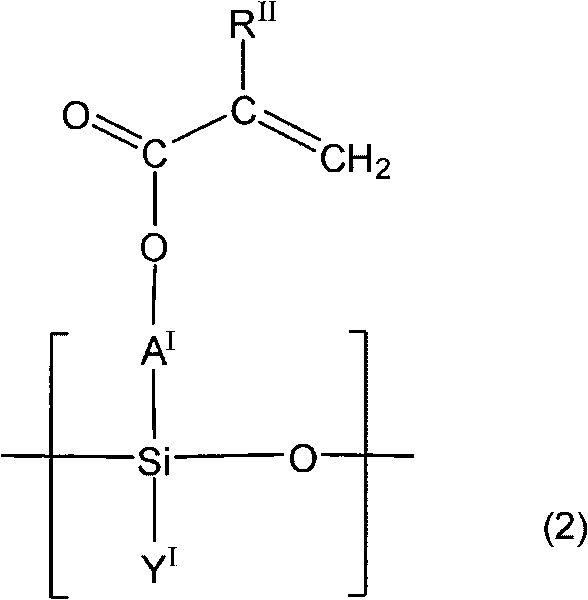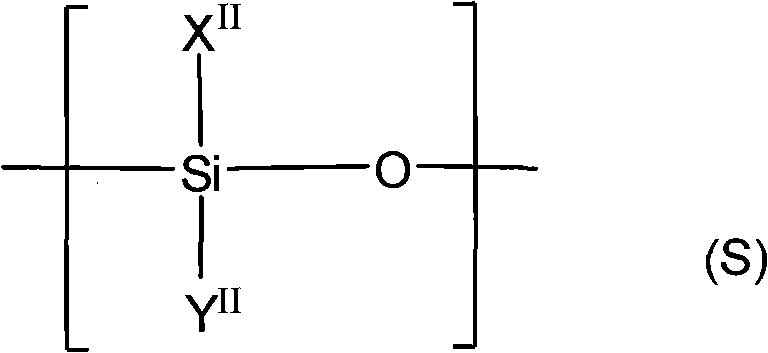Liquid crystal aligning agent, liquid crystal display device, and polyorganosiloxane
A technology of polyorganosiloxane and liquid crystal alignment agent, which is applied in the direction of liquid crystal materials, chemical instruments and methods, instruments, etc., can solve the problems of insufficient electrical properties such as voltage retention rate and afterimage performance, and achieve excellent and excellent liquid crystal alignment performance The effect of excellent electrical performance, voltage retention rate and afterimage performance
- Summary
- Abstract
- Description
- Claims
- Application Information
AI Technical Summary
Problems solved by technology
Method used
Image
Examples
preparation example Construction
[0132] When the above-mentioned poor solvent is used in conjunction with the organic solvent during the preparation of polyamic acid, its use ratio can be set appropriately within the range where the polyamic acid produced does not precipitate, and is preferably 50% by weight of all solvents. % or less, more preferably 20% by weight or less.
[0133] As mentioned above, the reaction solution which melt|dissolved polyamic acid can be obtained. This reaction solution may be directly supplied to the preparation of a liquid crystal aligning agent, or the polyamic acid contained in the reaction solution may be separated and then supplied to the preparation of a liquid crystal aligning agent, or the separated polyamic acid may be purified and then Preparation of liquid crystal aligning agent is provided. The separation of polyamic acid can be carried out by pouring the above-mentioned reaction solution into a large amount of poor solvent to obtain a precipitate, and then drying the...
Synthetic example 1
[0252] In the reaction vessel equipped with stirrer, thermometer, dropping funnel and reflux condenser, add 3-acryloyloxypropyltrimethoxysilane 50g, 2-(3,4-epoxycyclohexyl)ethyl 50 g of trimethoxysilane, 500 g of methyl isobutyl ketone, and 10 g of triethylamine were mixed at room temperature. Then, after adding 100 g of deionized water dropwise through the dropping funnel over 30 minutes, the reaction was carried out at 80° C. for 6 hours while stirring under reflux. After the reaction, the organic layer was taken, washed with 0.2% by weight of ammonium nitrate aqueous solution until the washed water was neutral, and the solvent and water were distilled off under reduced pressure to obtain polyorganosiloxane (APS- 1) Viscous transparent liquid.
[0253] The weight average molecular weight Mw of this acryloyl group-containing polyorganosiloxane (APS-1) was 2,000.
Synthetic example 2
[0255] Except that the raw material silane compound was 80 g of 3-acryloyloxypropyltrimethoxysilane and 20 g of 2-(3,4-epoxycyclohexyl)ethyltrimethoxysilane, the same procedure was carried out as in Synthesis Example 1 above, A viscous transparent liquid of polyorganosiloxane (APS-2) having acryloyl groups was obtained.
[0256] The weight average molecular weight Mw of this acryloyl group-containing polyorganosiloxane (APS-2) was 1900.
[0257]
PUM
| Property | Measurement | Unit |
|---|---|---|
| viscosity | aaaaa | aaaaa |
| viscosity | aaaaa | aaaaa |
Abstract
Description
Claims
Application Information
 Login to View More
Login to View More - R&D
- Intellectual Property
- Life Sciences
- Materials
- Tech Scout
- Unparalleled Data Quality
- Higher Quality Content
- 60% Fewer Hallucinations
Browse by: Latest US Patents, China's latest patents, Technical Efficacy Thesaurus, Application Domain, Technology Topic, Popular Technical Reports.
© 2025 PatSnap. All rights reserved.Legal|Privacy policy|Modern Slavery Act Transparency Statement|Sitemap|About US| Contact US: help@patsnap.com



